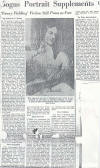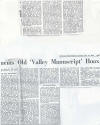Margaret (Lynn) Lewis, The Valley Manuscript,
Copyright 2010
: Revised 24 April 2019
For extensive collections of the history of Lynns, Linns,
Linds, etc.
What Lynn of Ulster Scottish origin who seeks out his or her family's history would not be delighted with "The Valley Manuscript"? It speaks of lochs, crags, and heather and then tells a romantic tale of 17th century Ireland and pioneer America. Many of the events it relates are known historical events, but other of its aspects have created a good deal of controversy. Therefore, any serious Lynn-Lewis student, historian, or genealogist would be lax if he or she failed to objectively examine that writing known as "The Valley Manuscript" ... ________________________________________ In January 1869, a North Carolina historical magazine published "The Valley Manuscript", submitted by Fanny Fielding, who described it as being "from a collection of archives known in our household by the above title, from which I have recently begun making excerpts ..." The article begins:
Margaret (Lynn) Lewis (1693-1773) was the very real wife of John Lewis, pioneer and founder of Staunton, Virginia. The 1869 manuscript describes, first, "the bonny loch and knowes [hills] of Lynn" with its "rock-crowned summit", its "crags", and "heather". It then describes Margaret's early life as the wife of John Lewis in Donegal, Ireland and then in Staunton, Virginia. The manuscript describes certain historical events in the lives of the Lewis family, including: (1) the victory of a son Andrew, and the death of a son Charles, in the 1774 battle with Chief Cornstalk of Point Pleasant; and (2) the participation of three Lewis grandsons, near the end of the Revolutionary War, in the successful defense of Staunton. These events are historically accurate; but other claims, discussed below, prove to be fictional. In April 1892, a West Virginia historical magazine reprinted the 1869 manuscript and added - unsourced - that Margaret Lynn, bride of John Lewis, was:
Unfortunately, no Clan Lynn or Linn, etc. is found in any reputable published list or history of Scottish clans.* Furthermore, the only Scottish legends of Lynns relate to persons who lived not in the Highlands of Scotland, but in the Lowlands: (1) The Ballad of Tam Linn, which concerns a young man, a maiden, and the Queen of Fairies and is set in Selkirkshire; (2) The Heir of Linne, a morality poem about another young man, who squandered his fortune, set in the neighboring Lowland counties of Dumfriesshire and Peeblesshire but often wrongly attributed to Ayrshire; and (3) The Wraith of Lord Lyne, a folk tale about a mother's premonition of the accidental drowning death of her son in Ayrshire.
While some Lynns of Scotland were lairds, Scottish law provided that titles referencing a property always referred to the land itself, and not to any body of water incident thereto. Furthermore, none of the three properties which Lynns held as lairds included a loch at all. So what of "The Valley Manuscript" itself? First and foremost in any assessment of a manuscript's authenticity is the identity of its author. The writer of "The Valley Manuscript" is no descendant publishing her ancestor's memoirs, but she cleverly gives the impression that she is by describing her manuscript as being "from a collection of archives known in our household ..." To the contrary, Fanny Fielding was a pseudonym of Mary Jane Stith Upshur, a 19th-century author of poetry and prose who submitted manuscripts to numerous southern literary magazines, at times under other pseudonyms and at times anonymously. One of her anonymous works is a novel entitled "Confederate Notes".
These three points and additional commentary were published sixty-three years before the publication of this page ... The Richmond Times-Dispatch - 1948 In February 1948, the Richmond, Virginia newspaper published an article entitled "Bogus Portrait Supplements Old 'Valley Manuscript' Hoax". The article includes the following criticism by Judge Lunsford L. Lewis, a direct descendant of Margaret:
"Bogus Portrait Supplements 'Old Valley Manuscript' Hoax"
Note: The amount of text on and physical size of these pages result necessarily in very large image file sizes. If you are unable to open or download them, we will be happy to email .jpg files, free of charge, upon request to Lynneage @ comcast.net. This article also briefly mentions an earlier critique which describes the manuscript as "a very good short historical novel ... or ... if you will ... one of the cleverest pieces of forgery I know of." That critique appeared seventy-one years after the first publication of the manuscript.
________________________________________ "The Valley Manuscript" is a very romantic but fictionalized account which deceivingly embellishes history with pure fantasy and thereby leads astray many Lynn genealogists in search of Scottish ancestors. "The Richmond Times-Dispatch" exposé of the manuscript reveals the story's lack of credibility more thoroughly than does this page. Also discussing a bogus portrait of Margaret (Lynn) Lewis, the exposé concludes: "Margaret Lynn Lewis, the first lady of Augusta, has indeed been shabbily treated. She, the wife of a pioneer and the mother of Virginia heroes, deserves something better of posterity than a faked journal and a phony portrait." As mentioned earlier, Fielding's story does contain some truth. Margaret did indeed come to the U.S. with her husband from County Donegal, Northern Ireland. However, the manuscript's claim that she was born in Scotland in 1693 cannot be proven, certainly not on the word of the manuscript itself. However, neither can it be disproven. A thorough search of Scottish births and baptisms for the years 1690 through 1695 reveals no Margaret Lynn, Linn, etc. born during those years; but of course some parish records have not survived. All things considered, though, it is also equally possible that she was born in Donegal, where in fact she married John Lewis and where Lynns had owned property since 1609 ~ see Lynns of Londonderry, Donegal and Tyrone. Unfortunately, precious little has survived in the way of documented Irish family history from the time Margaret was born until she and John left for America. Birth and marriage records prior to the mid 19th century, particularly for Protestants, are virtually non-existent; and all Irish wills of the period were lost in the 1922 bombing and fire at the Belfast court house. What does survive from Margaret's lifetime consists primarily of things such as land records, flax growers lists, religious returns, and muster rolls. That being said, land records and muster rolls do prove that a number of Scottish Lynns joined the first Ulster plantation and lived in County Donegal as early as 1609. The known history of the first Scottish Lynns of Northern Ireland is discussed at Lynns of Londonderry, Donegal, and Tyrone (below). At the same time, Margaret is included in the 1757 Fredericksburg, Virginia will of her brother, Dr. William Lynn (below), also an immigrant from Ulster. The will does not provide the names of their parents, but it does tell us a great deal about the family. Loretta
_________________________________________________________ |
||||||||||||||||||||||||||||||


